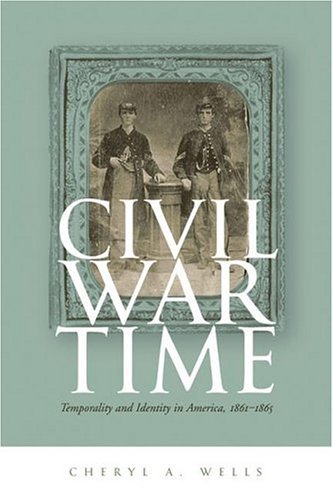
|
Cheryl A. Wells, Civil War Time: Temporality and Identity in America, 1861-1865. Athens: University of Georgia Press, 2005. 195 pp. ISBN 0-8203-2657-7. $39.95 (cloth). Reviewed by George C. Rable, for the Journal of Southern Religion.
| ". . . [Wells] points out how southerners eager to make a dollar had become increasingly conscious of the clock even as seasonal variations in time remained critical for agriculture." | |
The pervasiveness of time in daily life, however, makes such a subject both important and slippery. In dealing with this topic, historians can both belabor the obvious and offer telling insights. Wells maintains that antebellum Americans were governed by “clock time,” “natural time,” “God’s time,” and “personal time.” Following the lead of her mentor Mark Smith and other researchers, she points out how southerners eager to make a dollar had become increasingly conscious of the clock even as seasonal variations in time remained critical for agriculture.
The Civil War brought a new kind of time, “battlefield time,” that disrupted what Wells terms people’s “temporal web.” Anyone who has examined after-action reports and other documents quickly realizes that establishing the time an attack was launched or ended is often difficult. Wells makes the important observations that watches were often not synchronized and that even establishing the local time could prove challenging. Yet in war as in other aspects of life, timing was literally everything. Delays in the Union advance toward Manassas, Virginia, in July 1861, the transfer of General Joseph E. Johnston’s troops to General P.G.T. Beauregard’s command, and the dependence of both Union and Confederate armies on a “clock-regulated offensive battle plan” (p. 23) all helped determine how First Bull Run was fought. Wells notes that General Irvin McDowell had “failed to graft clock discipline onto his commanders and civilian soldiers” (p. 31), though that statement might apply to a greater or lesser degree to all major Civil War battles. Inadequate communications and staff work meant that even the best Civil War generals could never quite manage to have all the parts of their vast armies working together; ultimately commanders could not overcome problems of time and space. Ironically, it was Beauregard (the victorious commander at First Bull Run) whose overly complex marching orders and battle plans failed to take into account the difficulties in timing movements of large numbers of troops at Shiloh. The result was a bloodbath on an unprecedented (though soon to be duplicated) scale.
Wells believes that generals typically “failed in their attempts to inscribe clock time onto the messy reality of the Civil War yet proceeded as if such attempts had succeeded” (p. 32). Gettysburg certainly illustrated this problem for the Confederates. Lee’s inexact orders and dependence on subordinates’ sense of timing meant that from July 1 on confusion often reigned in the Army of Northern Virginia. As for the Union and Confederate soldiers themselves, they had their own sense of time in camp and soon learned that scheduled duties largely governed their days. Pious men noted how God’s time—the Sabbath—was hardly sacred in the army. Only marches and battles could overshadow the clock time that generally governed the rhythms of soldier life.
Obviously ideas about time carried importance well beyond the camp and battlefield, but Wells’s attempt to extend her analysis into hospitals largely falls flat. Following the lead of several previous scholars, she maintains that women working in hospitals challenged traditional notions about gender, but the evidence presented is far more interesting than the argument itself. Examples of nurses working according to schedules, dealing with sometimes difficult surgeons, and handling sudden influxes of badly wounded men grab the reader’s attention, though the interpretation of this information strains for significance. The conclusion to chapter four: “The silencing of battle thus marked an end to the temporal freedom women had experienced in Civil War hospitals” (p. 88) is at once opaque and jejune.
The chapter on prisons is more successful. Wells points out how both sides miscalculated the time required to fight the Civil War and were therefore ill prepared to handle a veritable flood of prisoners. Clock time regulated prison life, but time hung heavy for most men, and of course events on the battlefield would determine the timing of prisoner exchanges and releases. Yet despite all the deaths on battlefields, in hospitals, and in prisons, the Civil War seemingly failed to transform Americans’ sense of time. Wells in fact concludes that after the Civil War, people rushed to restore antebellum “temporal rhythms” in fields and factories. Once again clock time would emerge triumphant.
The greatest strength of Civil War Time is its wide ranging research. Wells has uncovered much good if not exactly new information on how Americans defined and thought about time. Her descriptions are clear and her quotations well chosen, but the analysis sometimes becomes banal. The word “hegemonic” serves as an all-purpose but seldom illuminating interpretative crutch. The concluding the paragraph to the Gettysburg chapter on p. 53 is a prime of example of why academic cultural history attracts relatively few readers: it sounds impressive, but what does it mean? Wells has gathered some fascinating material and offers some stimulating observations, but she needed to give more careful attention to the always difficult “so what?” question in further honing her analysis.
George C. Rable, University of Alabama
© 1998-2005 by The Journal of Southern Religion. All rights reserved. ISSN 1094-5253




